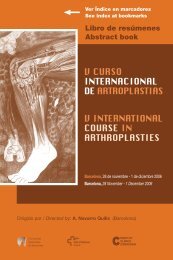Notas / Notes - Active Congress.......
Notas / Notes - Active Congress.......
Notas / Notes - Active Congress.......
Create successful ePaper yourself
Turn your PDF publications into a flip-book with our unique Google optimized e-Paper software.
JUEVES / THURSDAY<br />
122<br />
12.15 - 14.15 h<br />
RODILLA / KNEE<br />
Unicompartimentales / Unicompartimentals<br />
Modereador: Peter McLardy-Smith<br />
UNICOMPARTMENTALS: OSTEOTOMY,<br />
INTERPOSITIONAL DEVICE OR<br />
UNICOMPARTMENTAL?<br />
Thomas S. Thornhill M.D., John B. and<br />
Buckminster Brown<br />
Professor of Orthopedic Surgery, Harvard Medical School<br />
Orthopedist-in-Chief, Brigham and Women’s Hospital<br />
Boston Massachusetts<br />
California (USA)<br />
In the 1970’s and early 1980’s, unicompartmental knee replacement<br />
(UKA) in our institution was utilized in 30-50% of<br />
patient’s undergoing arthroplasty for osteoarthritis. With improvements<br />
in total knee replacements (TKA), difficulties in<br />
patient selection of UKA and concerns over long-term success<br />
of UKA this procedure fell out of favor. In the 1990’s only 5-<br />
8% of osteoarthritic patients in our institution underwent UKA,<br />
while in other institutions the procedure was abandoned. In<br />
the past few years, UKA has had a rebirth based primarily<br />
on the “mantra” of minimal invasive surgery. It is heralded<br />
as a “interval arthroplasty” or “prelude to a total knee”. While<br />
the pattern of osteoarthritis has not changed the incidence<br />
of UKA has risen sharply leading to concerns of patient selection<br />
and, with minimal exposure, difficulties in interoperative<br />
joint assessment and component implantation.<br />
These concerns are validated by a review of the literature<br />
in the 1970’s and 1980’s, which indicated that the most common<br />
causes of failure included poor patient selection, difficulty in<br />
intraoperative decision making when considering UKA vs.<br />
TKR and technical error during surgery. UKA is contraindicated<br />
in cases of inflammatory arthritis; significant involvement of<br />
2 or more compartments, subluxation, significant extra articular<br />
deformity, or the presence of active or untreated infection.<br />
UKA is relatively contraindicated in obese patients,<br />
those with significant chondrocalcinosis and in anterior<br />
cruciate deficient knees. With these criteria applied only 5-<br />
8% of osteoarthritic patients should undergo UKA. Have we<br />
stretched the indications for this procedure? While many<br />
patients previously considered for tibial osteotomy now may<br />
be considered for UKA this may explain a portion of the<br />
increased numbers. The increase utilization of both marrow<br />
based and cell based therapies for cartilage repair however<br />
should offset this increase.<br />
Joint inspection at the time of arthroplasty has always been<br />
an important factor in considering UKA vs. TKA. The status<br />
of the uninvolved patella femoral compartments, the presence<br />
or absence of significant osteophytes, the presence or absence<br />
of the anterior cruciate ligament, the wear pattern of the involved<br />
compartment and the extent of inflammation have all<br />
been considered as important determinants. Another potential<br />
concern in minimally invasive UKA is the inability to carefully<br />
inspect the remaining joint.<br />
Finally, technical issues are a major factor in determining<br />
the success or failure of UKA. In one series from our institution,<br />
we found a 17% incidence of technical issues that lead to<br />
early failure. These included under-correction, over correction,<br />
component mal-rotation, residual incongruity, non-parallelism,<br />
instability and wear of the unresurfaced compartments. UKA<br />
in fact is a technically more demanding procedure than TKA.<br />
If 70% of the total knees done in the US are done by people<br />
who do less than 30 a year and if UKA patients represent<br />
only a fraction of the knee arthroplasties performed, there<br />
is a question of the critical number necessary to maintain<br />
proficiency with this procedure. Moreover, UKA through<br />
minimally invasive techniques often has less instrumentation<br />
than either TKA or UKA through standard incisions. As component<br />
systems are driven towards minimally invasive surgery,<br />
the precision of the instrumentation may necessarily be<br />
compromised.<br />
UKA remains a useful procedure for treatment of patients<br />
with osteoarthritis and minimally invasive techniques certainly<br />
have an advantage. It is hoped that the problems recognized<br />
in the 70’s and 80’s are not revisited in this era of minimally<br />
invasive surgery. Below is an outline of the options available<br />
to treat Unicompartmental Arthritis.<br />
Current indications for specific treatment in<br />
non-inflammatory osteoarthritis<br />
Arthroscopy- evidence of internal derangement, normal<br />
alignment, preservation of joint space<br />
Arthroscopic debridement<br />
-impinging osteophytes (intercondylar, patellofemoral)<br />
-sealing techniques (not validated)<br />
Open debridement-limited





